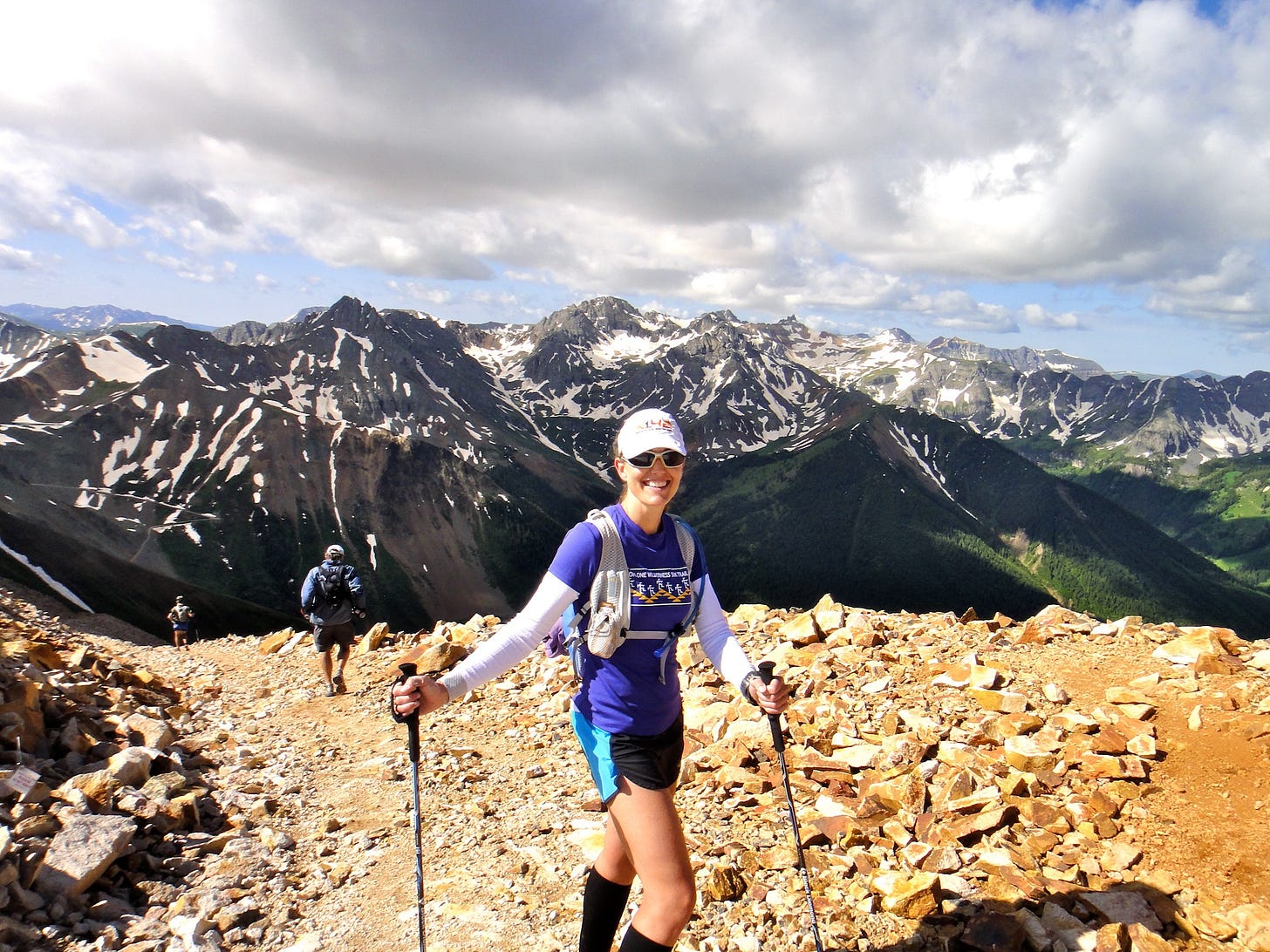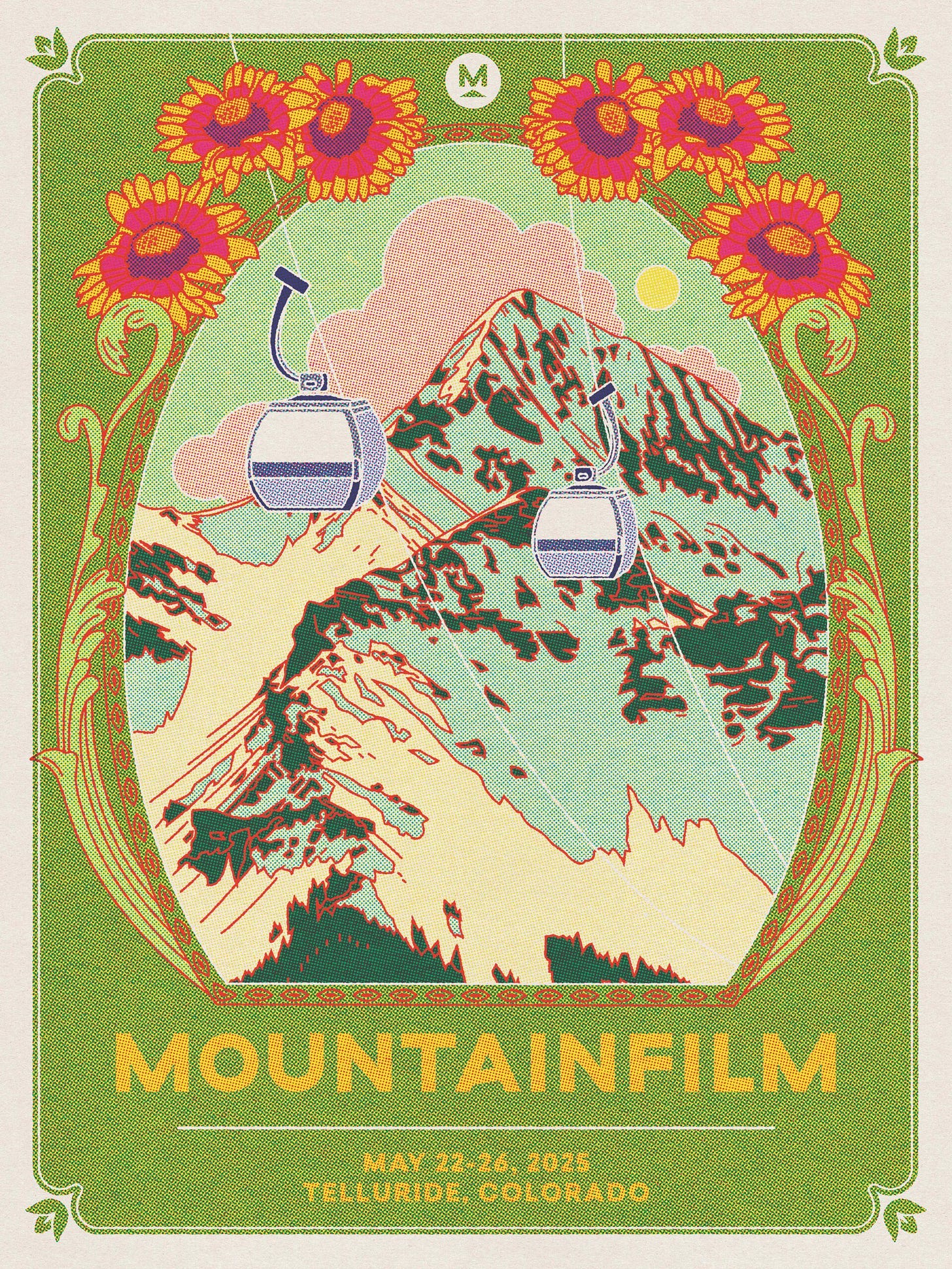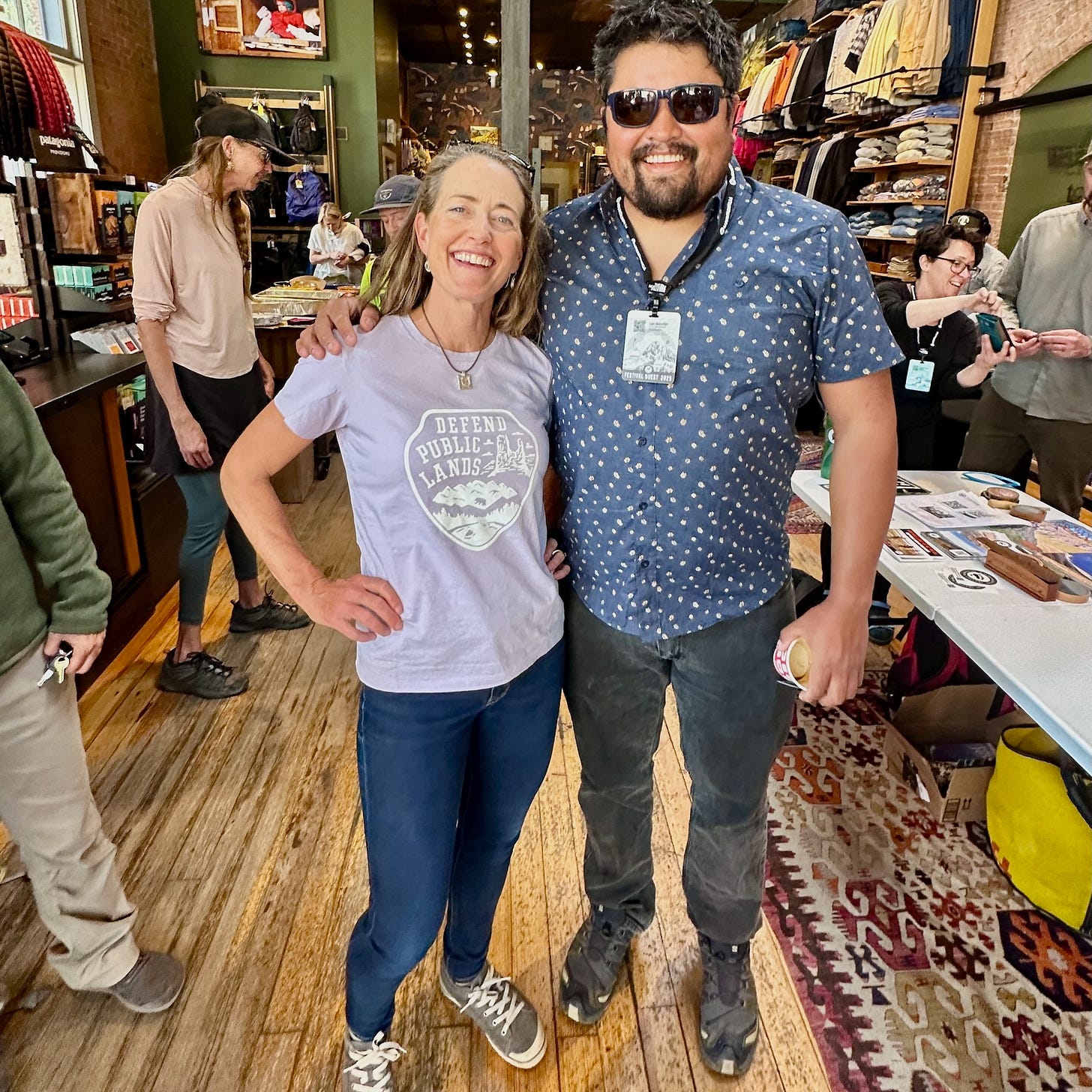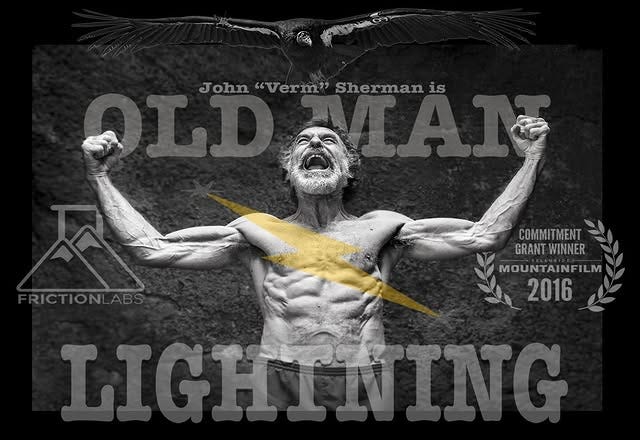I’ve written before about the value of retreats—of taking a break from regular life to immerse yourself in a place and to focus on an activity such as writing or running, in community with others doing the same—and how it expands the mind as well as refreshes the body. This past weekend, I had an experience that felt like a retreat, even though I didn’t physically travel anywhere. It felt like a special, mind-blowing “staycation,” and I share it below with the hope it you’ll have a chance to experience it, too.
But since many of you are here for running-related content, I also have a running story. It came out in another publication this week, Telluride Magazine. It’s about my 14-year journey to earn a spot on the Hardrock Hundred’s starting line this July 11, and why Hardrock became such a big deal to thousands of runners worldwide. It begins: My baptism by Hardrock happened in 2011, when I was 42.
I describe the route’s beauty and ruthlessness, the effort to gain an entry through the long-shot lottery, and the history of the event. It includes an interview with an old-timer who was at the first Hardrock in 1992, and anecdotes from run director Dale Garland about Kilian Jornet and others. I put my heart into writing the piece, and if you have any curiosity about Hardrock, I hope you’ll read it here.

The magic of MountainFilm and four films you should see
Telluride has an incredible film fest that is the one local festival I personally feel is worth the time and money to experience, but it’s not the Telluride Film Festival. That other one, which is more famous, takes place at summer’s end over Labor Day weekend and draws Hollywood celebs.
I’m talking instead about MountainFilm, over Memorial Weekend, and for 47 years it has showcased documentary films that portray the most moving and extraordinary aspects of the human spirit and the natural world.
The four-day experience isn’t just about watching films, however. It’s meeting and talking to others, swapping ideas and reactions. The mornings start with panel discussions; in one, I listened to Cheryl Strayed and other women writers discuss writing for change. By writing the truth, she said, and writing about our often scary or regrettable experiences, we open doors of awareness in others to help them make change.
Then I queued up outside the theater venues and rediscovered that talking with others while waiting in lines is one of the surprising pleasures of MountainFilm. Collectively, we sat in theaters transfixed by short and feature-length documentaries. Watching movies on the big screen, with devices off and put away, feels like a lost treasure, much more valuable and powerful than distractedly streaming a show at home.
I saw “only” four feature-length films and 10 shorts—a small fraction of all the films that screened, but about all I could handle given we had to return home during the day to take care of our animals, and plus, I needed to fit in some running. I’ll highlight and recommend four of them here.
I hope you’ll seek out the films below, consider attending MountainFilm in 2026, and also look at MountainFilm On Tour to find out about screenings around the country.
The American Southwest: This film surprised me and, if I had to choose, was my favorite of all I saw. Good news: It will open in theaters around the West in early September, so you may be able to see it near you.
I knew going into it that it’s about the Colorado River, and I expected it to be serious and policy-heavy. It’s serious, yes, but also fanciful and utterly captivating with the most incredible cinematography I’ve ever seen. It achieves its aim of illustrating the river’s ecosystem, and what’s a stake with the river’s use and management, by creating characters out of species that live along it. Elk, beaver, jaguar, condor, rattlesnake, trout, and the salmonfly become the film’s stars with dramatic up-close shots that show how they live and depend on the river. I did not expect this film to be humorous in parts, but it made me laugh, and it also made me cry. Few nature films deliver such an emotional hit.
I hope as many people as possible see this enlightening film and feel motivated to work to save the riparian habitat, and I predict it will get an Oscar nomination in the documentary category, it’s that good. Follow @finandfurfilms on Instagram for updates on its release.
Side note: one of the producers and cinematographers on The American Southwest is
, a writer here on Substack. He’s a brilliant, funny, and multifaceted scholar, storyteller, and indigenous activist, and it was very cool to meet and chat with him a couple of times during Mountainfilm. In this photo, we’re at the Telluride Patagonia store for a public-lands event where I was at a table sharing info about Conservation Lands Foundation.Girl Climber: If you follow climbing, which I don’t, you probably know about Emily Harrington. I knew about two of her more famous mentors, Alex Honnald and Hilaree Nelson, both of whom feature prominently in this film, but somehow I had missed Emily’s story of breaking barriers in the climbing world. I am so grateful I got to see this gripping film about her multiple attempts to become the first woman to free climb Yosemite’s El Capitan in under 24 hours.
Her strength and skill inspire, but it’s her resiliency and struggle to overcome self-doubt that hooked me. This is the film I needed to see before my attempt at Hardrock. When I trip and bloody myself, I’ll picture Emily’s gashed forehead and recall her cries of pain when she was two-thirds of the way up El Cap. When I want to give up from fatigue, I’ll visualize how she stretched and pulled herself up as her muscles trembled. You don’t have to be a climber to love this film.
For updates on its screenings, I suggest following the Instagram account of the director Jon Glassberg:
Old Man Lightning: This is another climbing film, also set in Yosemite, but completely different from Emily Harrington’s story. It’s about John “Verm” Sherman, a washed-up old dude with a Homer Simpson belly who used to be a famous climber, specializing in bouldering rather than big walls. He climbed the storied Midnight Lightning boulder in Yosemite in his heyday, 25 years ago, but then got soft through beer drinking and bird watching. He embarks on a comeback in midlife to get back in shape to conquer Midnight Lightening again—but the story becomes the setbacks that keep getting in the way of his big goal.
This is perhaps the funniest film to play at MountainFilm, even though it has a serious side. If you like Rocky-esque get-in-shape montages set to retro power rock, or spoof commercials promoting adult diapers for graying athletes, it’s for you. Yet it has heart as well as humor, in part because the director is Verm’s partner, and their relationship shapes the film. I hope it becomes available through screenings or online for more people to see it.
Here’s a post about it from director Dawn Kish:
The Life We Have: Finally, I’ll highlight a tear-jerker of a running film, a short documentary (24 minutes) about a runner nearing life’s end yet maintaining his run streak. Rob Shaver speaks to the camera with a graying beard (which falls out in clumps from chemo) while wearing a Cocodona Virtual Run T-shirt. He describes his recurring stage-four cancer that riddled his lungs and other body parts with tumors. Yet he keeps getting out the door to run daily. So does his nearly 70-year-old mother, who takes care of him and runs by his side, and his brother. Together, they value each day and each run. Rob’s message to “love your body” made me feel deeper appreciation for my healthy body and its ability to run regardless of speed or distance. For updates on where it’s available to view, check this site.
Two book recs on adventure and running
I devoured two books in the last two weeks, one about climbing and the other about running, and I could picture a film version of them in my head because each is so cinematic and dramatic.
Thirty Below: The Harrowing and Heroic Story of the First All Women’s Ascent of Denali by
is historic nonfiction, set in the late 1960s through 1970, and it definitely is harrowing and heroic, as the subtitle promises. What these six women did as mountaineers is extraordinary given the era and the barriers. At the time, my mom was in her early 30s raising my older sibs and getting pregnant with me while leading the kind of housewife life portrayed on soap operas. Being an intrepid female mountain climber was completely on the fringe and more condemned than celebrated.I attended a book talk by the author, Cassidy Randall, last week because she was in town for MountainFilm, and I’m overflowing with admiration and respect for how she pieced together these women’s stories, their ascent, and their conflicting personalities through journals, interviews, and archives. She puts us in the cumbersome snow shoes and ice caves that these women wore and dug so we feel what it must have been like to barely survive Denali’s conditions. At points it felt so painful, I didn’t want to keep reading, but I’m glad I did to appreciate an overlooked story from the second wave of feminism.
For fiction and a trip to the early 1990s, I recommend We Loved to Run by Stephanie Reents, which will be released in August (I read an advanced copy). From its first chapter, We Loved to Run draws the reader into the all-consuming drama and sacrifice of being a top runner on a collegiate cross-country team. “We hated running, and we loved it. We spent so much time trying not to think about our bodies that we were always thinking about them. Thinking about how they were not hungry or not injured or not fatter or weaker than the body of some other girl. Running was the glue that kept us together, but it was also a truth serum, drawing out feelings we’d rather not have.”
You can tell the author was a dedicated XC runner herself because she vividly captures the movement, energy, strategy, discomfort, and emotions of the meets as well as of the training runs. But, this is not a book about running as much as about relationships and these lonely girls’ need for friendship, and the care they feel for one another, which ultimately overrides their competition. Read my full review on Goodreads here.
Tomorrow (May 29) I host a monthly chat via Zoom with paid subscribers. If you’d like to participate in the online meetup and receive occasional bonus posts, please consider upgrading your subscription to the supporter level.








It was great to see you for a few minutes!
I was seeing lots of pictures of friends who were at the event and now I'm even more keen on attending one of these years. Thanks for the great recap.
I heard Dr. Len talking about his new film on The Landscape podcast a few weeks back. Really looking forward to seeing that one.